CHUCK'S 1971 GE WILDCAT PHONOGRAPH - A RETRO TURNTABLE MODDING EXPERIENCE
How to turn a bland old dropchanger phonograph into a swank rockin' turntable!
By Chuck Miller
A few years ago, I found at a yard sale a 1970's-era General Electric "Wildcat" V931 phonograph, similar to one I owned as a child. It was a four-speed drop-changer turntable with a belt-driven robotic tonearm, a record player that could fold up into a attaché-shaped carrying case. Three knobs on the side controlled the record's volume, balance and tone, while two adjustable triggers allowed the user to set the song's speed, or to reject the record in mid-play.
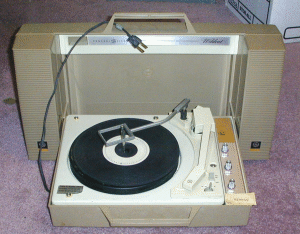 Unfortunately, the previous owner of that Wildcat did not take decent care of it - the tonearm and headshell were seriously out of alignment; the rubber mat had puckered and was loose; and the internal oils had dried to the consistency of caulk. Upon further review of the player, I discovered that the power cord had split and frayed near its connection with the player, certainly a fire hazard. I attempted to locate another Wildcat phonograph, but the good ones were selling online for $75 (brown ones) to $150 (olive green or black), definitely out of my price range. Unfortunately, the previous owner of that Wildcat did not take decent care of it - the tonearm and headshell were seriously out of alignment; the rubber mat had puckered and was loose; and the internal oils had dried to the consistency of caulk. Upon further review of the player, I discovered that the power cord had split and frayed near its connection with the player, certainly a fire hazard. I attempted to locate another Wildcat phonograph, but the good ones were selling online for $75 (brown ones) to $150 (olive green or black), definitely out of my price range.
Eventually I decided it was time to do something significant to this Wildcat. For me, that meant giving it a new look, a new style, so that this unit could truly sparkle and shine.
As you can see from the photo above, this player, although aesthetically appealing, looks extremely plain. The rubber turntable cover is warped, and the light brown shell has age marks on it. The 45 RPM spindle adapter has long disappeared from this unit. The flip-over stylus, one that has a smaller point (for 45's and LP's), which can be flipped to reveal a fat point (for 78's), had worn down to nothingness on both sides. This machine is screaming for an overhaul, both cosmetically and mechanically.
The most important thing to remember, when working on restoring your Wildcat, is to make sure you know something about electronics and wiring. You'll eventually have to solder some parts together, and this may also require some skill and patience. After a search for an electronics expert that specialized in vintage 1960's and 1970's phonographs, I found Scott Phillips at "For Your Listening Pleasure," an electronics repair shop in Binghamton, New York, about 3 1/2 hours from my Albany home. We decided to split the machine restoration project into two sections. Disconnecting the turntable and motor apparatus from the case, Phillips would clean the parts and bring the motor and turntable back to a dependable, safe function, while I took the high impact case and all the plastic and chrome parts back to Albany for some restoration work of my own.
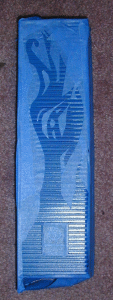 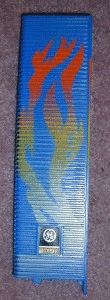 After cleaning the case to remove any dirt and gunk, and removing any applied decals or trademarks with UN-du sticker removal solvent, I purchased two cans of Krylon's "Fusion Safety Blue" spray paint, which could be applied to plastic without a primer. I carefully masked off the back of the speakers so that no paint would stain the inside, then gave each piece a light dusting of blue paint - then a heavier coat 20 minutes later - then a final coat after a 12-hour curing period. Make sure you're wearing safety goggles and a dust mask when spraying paint. The end result - the cabinet shimmered with a deep blue hue. After cleaning the case to remove any dirt and gunk, and removing any applied decals or trademarks with UN-du sticker removal solvent, I purchased two cans of Krylon's "Fusion Safety Blue" spray paint, which could be applied to plastic without a primer. I carefully masked off the back of the speakers so that no paint would stain the inside, then gave each piece a light dusting of blue paint - then a heavier coat 20 minutes later - then a final coat after a 12-hour curing period. Make sure you're wearing safety goggles and a dust mask when spraying paint. The end result - the cabinet shimmered with a deep blue hue.
Blue is a nice color for a phonograph, but I thought some flames up the sides of the speakers would look particularly swank. Cutting some painter's tape into strips, wedges and curves, I taped up the sides of the speakers to create a flame stencil. I didn't follow any pattern of how the flames should rise up on the speakers; I simply went with my gut and instinct. Originally the plan was to have the flames look similar to those on the side of a hot rod; eventually the flames looked more like those found in a stained glass window of a house of worship.
I then broke out the red, yellow and turquoise plastic spray paints. Starting at the base of the speakers, I sprayed a light dusting of turquoise, then a light strip of yellow in the middle, then a strip of red at the top. I layered the yellow and red so that they would blend smoothly as the flames rose up the speaker - then I left the project to sit for a couple of days. After removing all the wedges and curves and strips of painter's tape, I was amazed at the striking results. I then re-applied the decals so that the unit would retain its General Electric identity.
As the last drop of paint dried on the project, Scott Phillips called me. My Wildcat motor was repaired, a new power strip was attached to bring the unit up to code, and he even installed a new flip-over stylus so that I could play LP's, 45's AND 78's without any problem. He even acquired a new 45 RPM spindle for the unit. I drove back to Binghamton, and we put the phonograph back together.
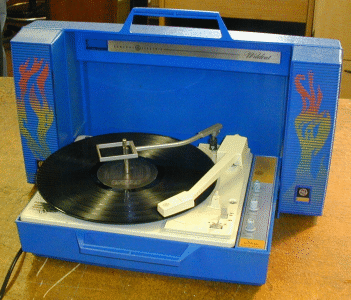 And here's the completed project, a work of art that doubles as a "rock and roll" phonograph, funkier than anything that ever came out of the General Electric laboratories. And here's the completed project, a work of art that doubles as a "rock and roll" phonograph, funkier than anything that ever came out of the General Electric laboratories.
And if it was going to stay like that, I would have been happy... but for some reason known only to me, I wanted lights. Flashing lights that pulsed to the beat of the music.
At one point, I thought I could install an LED-based VU meter in the upper bracing bar (where the metal "GE Wildcat" strip sits), but that would have involved drilling and other delicate work, and the last thing I needed was something with big gougy holes in it. Eventually my search for light-emitting diodes brought me to CanaKit, a Vancouver-based electronics company. I purchased two pulsating light panels, then ran crocodile clips from the speakers in the cabinet, to the connecting nodes on the light panels. I attached the panels to the back of the Wildcat with velcro strips, so that the unit could be easily assembled and disassembled.
Okay... you want to see what it looks like now?
TA-DAA!!
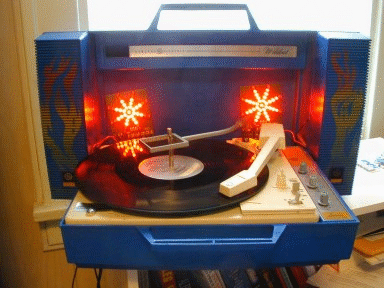
Ain't that a beauty? You can play anything on this phonograph now, from Pink Floyd's Dark Side of the Moon, to a pulsating funk breakdown, and the lights will bounce like the indicators on an electrocardiogram machine. Fantastic!
|
|
GE WILDCAT AUCTIONS ON eBAY
|




